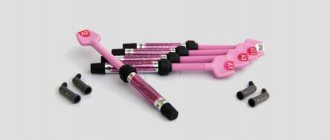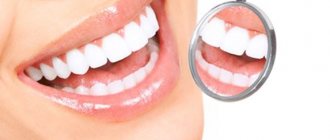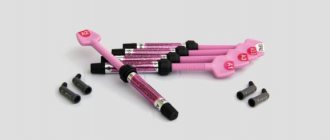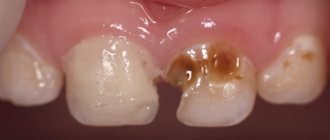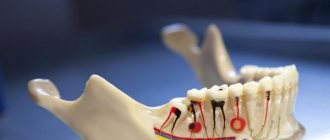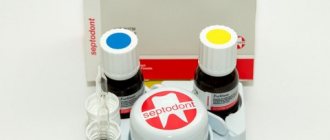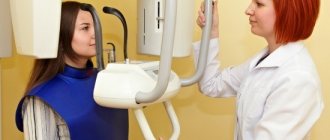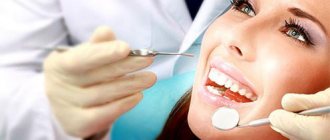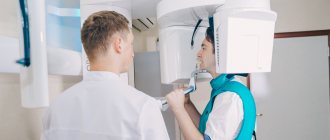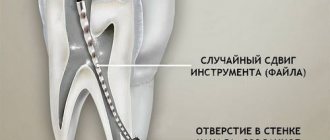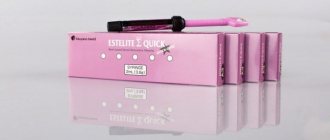Foredent is a material based on resorcinol-formalin resin, used for permanent filling of tooth root canals. Available in the form of powder and liquid, which when mixed form a special paste with a disinfecting effect, from which permanent fillings are made. Sealer Foredent is the simplest and most affordable product, used everywhere in most clinics in the CIS.
Key features of the material
The substance is produced by a Czech company – Spofa Dental. The product is fully certified and safe for use according to all European standards. The main components of the drug are resorcinol and formaldehyde. These components are included in a set consisting of 40 grams of powder mixture and two containers with liquids of 25 grams each.
The dental product Foredent is a material that has long proven itself to be simple and easy to use. A filling preparation created on the basis of resorcinol-formaldehyde resin has a huge number of advantages when working:
- easy to process;
- remains unchanged in volume;
- fits well into the canal;
- has a strong disinfectant effect;
- radiopaque;
- guarantees reliable tightness of the sealed canal.
The paste hardens in about an hour. The filling mixture becomes completely hard within a week.
The manufacturer of the drug recommends storing Foredent in a cool, dark place at temperatures from +5 to +25C.
Composition and production of phenolic plastic
Compression of phenolic plastics is considered the main production process. But according to its type, this phenol plastic can have different properties. Differences in the characteristics of the finished material are based on the use of different fillers. According to the type of filler, phenolics can be of two types:
- • dispersed-filled
- • reinforced.
The fillers of this material are press powders. These powders have different structures. The FP also includes:
- • phenol-formaldehyde resins,
- • silicon organic compounds
- • plasticizers,
- • lubricants in the form of stearin or oleic acid,
- • dyes.
The production of phenolic plastics is based on the process of rejecting all of the above components. The hardening process takes place at high temperatures. Phenolic plastics are processed in two ways - casting and pressing.
Instructions: Foredent
The most important substance of the drug, resorcinol-formaldehyde resin, is a toxic substance that causes negative consequences if inhaled or in contact with open skin and mucous membranes. For safety reasons, the tooth to be filled must be completely isolated from neighboring tissues. To achieve this, dentists use rubber dam substances.
Installed rubber dam on a tooth
Work with Foredent substance only with gloves and in a well-ventilated area. If the drug gets on the skin or mucous membranes, it is necessary to treat the area with water as soon as possible.
Rules of use and possible consequences
Correct work with Foredent material involves following the following instructions:
- the preparation of the mixture, as well as further filling of the canals, is carried out only with gloves to avoid direct contact;
- If the components get on mucous tissue or skin, it is necessary to rinse the affected area with plenty of water.
If filling with the drug is performed in the vicinity of the maxillary sinuses, the material can cause the development of sinusitis. In cases of contact with nerve endings, degenerative changes in tissues may occur.
Restrictions and contraindications
Foredent tends to change color over time, so its use on the front teeth is undesirable. Pink-brown areas on the front incisors look extremely unsightly. Such a defect can only be eliminated using camouflage agents such as veneers and lumineers.
Resorcinol-formaldehyde material must be used extremely carefully, taking into account all the nuances. When toxic components get on various tissues, they have a harmful effect on them. Formaldehyde, which is part of Foredent, tends to permeate tissues and penetrate beyond the boundaries of the tooth, so it is necessary to carry out isolation very carefully.
Potent substances that enter the oral cavity and respiratory tract lead to negative consequences, so strict adherence to the marginal seal of the filling is required. Substances in Foredent may be allergens, so it is necessary to clarify whether the patient is allergic to the components of the drug. A person may experience a reaction to toxic substances if the paste gets beyond the apex.
The cavity is filled with Foredent only up to the apex.
Opinion about the drug
The use of resorcinol-formaldehyde substances in modern practice raises much debate about the safety and appropriateness of their use. Some dentists call this mixture very dangerous for the human body. The main materials used are highly toxic. Filling pastes have mutagenic properties and have a teratogenic effect. Formaldehyde has the ability to spread throughout the body and gradually poison it. Teeth filled with resorcinol-formaldehyde resins cannot support dentures.
For a very long time, dental canal fillings have been performed using resorcinol and formaldehyde. Over many years, the manufacturer has learned to make the safest drug, Foredent, that meets all standards. It is one of the most common dental materials in the world. All components and quality of the paste meet all European standards. Foredent is certified and recognized by leading dental clinics in the world.
Physical characteristics and properties of DBP
DBP plasticizer has an oily and liquid consistency. The color of this substance has a slight yellow tint. It is almost impossible to dissolve with water, but it dissolves perfectly with ethanol, gasoline, various alcohols or acetone.
Organic solvents also provide a good environment for complete dissolution. The boiling point of DBP is 340 °C. This substance does not have strong viscosity.
Plasticizers by their nature:
- • compatible with polymers,
- • have a low degree of volatility,
- • do not have a characteristic odor,
- • chemically inert substances,
- • non-toxic.
The entire group of plasticizers around the world is divided into:
- • butyl alcohol phthalates, DBP,
- • octyl alcohol phthalates, DOP,
- • alcohol phthalates C9 and C10 and other ethers.
Price Foredent
The price of Foredent varies. On the Internet, the cost of one set, consisting of 40 grams of powder and two containers of liquid of 25 grams each, ranges from 339 rubles to 473 rubles. In Russia, the average price of filling material is 400 rubles. In Moscow pharmacies, the cost of Foredent can reach up to 600 rubles.
Purposes of use
Foredent is well suited for filling root canals after pulp removal. Intended for use in periodontal treatment and for the manufacture of fillings relating to the apical foramen (foramen apicale).
Filling material can also be used for additional surgical procedures (alveolotomy, root tip resection, periapical curettage).
Analogues of Foredent
There are many analogues of Foredent on the market. The most common of them:
- Resorcinol is a Russian analogue based on formaldehyde components. Manufactured by Omega.
- Rezodent is a preparation with a disinfectant effect used for disinfection of root canals and fillings. The composition includes an x-ray contrast filler and resorcinol with special additives. Produced in Belgorod. Price from 130 rubles.
- Forfenan is a French analogue for filling infected canals. The price of the set is from 5,000 rubles.
Foredent has been the main material for filling root canals for many years due to its reliability, ease of use and availability. Analogs on the market are either too expensive or not as versatile and easy to use.
Analogs and price of material
The price of Foredent varies. In online pharmacies you can order one set (40 g of powder + 2 x 25 g of liquid) at a price of 309 rubles. In pharmacies the same packaging can be purchased from 325 rubles. up to 450 rub. In Moscow, the cost of the drug can reach 500 rubles.
There are many analogues:
- Rezodent (Belgorod) - paste for filling and antiseptic treatment of difficult-to-pass canals, consists of resorcinol-based powder and x-ray contrast filler;
- Forfenan (France) – a mixture for filling canals that are infected;
- Resorcinol is a formaldehyde paste produced in Russia (Omega).
There are other analogues that can compete with Foredent.
Pros and cons of the latest technologies in pediatric dentistry
In pediatric dentistry, there has always been a desire to make treatment as easy and enjoyable as possible for the child. A number of alternative treatment methods have been developed. Some of them will be discussed below.
ICON - to drill or not?
ICON is a method of sealing the very initial stages of the carious process with a special type of resin. Initial tooth decay usually appears as chalky spots on the front surface of the teeth. That is, caries can be treated without drilling. If the stains are whitish, it is likely that after treatment the stain will become closer in color to the natural tooth. Often it is possible to improve the situation only slightly; pigmented spots are less amenable to lightening. Unfortunately, despite the five-year period of use, there are still no extensive studies of the long-term results of using the drug.
Practicing doctors cannot guarantee that the carious process can be stopped in this way; there are no independent studies on the durability of such restoration of the defect and the future prognosis of the tooth.
Treatment of caries in children with this drug is associated with a number of difficulties. After all, the tooth is etched with hydrochloric acid, so the gum tissue must be isolated with a rubber dam and the duration of the procedure is about 15-20 minutes. These procedures cannot be performed for restless children and children under 3 years of age.
The cost of treatment with ICON is comparable to the cost of restorations, therefore, in most cases, preference is given to proven methods with a known result, and this is remineralizing therapy in the earliest stages of enamel damage or restoration with modern materials after complete removal of infected tissue.
Laser dental treatment
Laser tooth preparation is the most interesting in terms of its prospects, since it makes it possible to clean carious tissues painlessly and silently. The ability to evaporate only decay products and strengthen the enamel creates the impression of a laser as a panacea against childhood suffering during an appointment. Indeed, many properties of the laser are very convenient for the doctor, especially in terms of performing surgical interventions. From the point of view of caries treatment, more extensive research and improvements are still required, since difficulties remain in the preparation of enamel. The tooth still requires refinement with a regular bur; tissue can be safely cleaned with a laser only to a shallow depth; in deep cavities there is a danger of the tooth overheating and the development of complications. The question of protecting surrounding tissues from accidental exposure to a laser beam during operation remains open. Fidgets and playful people who cannot sit in a chair can involuntarily move the doctor’s hand and cause laser damage to the gums.
Therefore, lasers are most successfully used today in surgical dentistry (on our website there is a wonderful page about the use of lasers in dentistry); its use in the treatment of caries is still very limited.
Air abrasive preparation
This is a method of removing carious tissue using small particles of soda or aluminum oxide, which are fed under high pressure through a special tip to the tooth tissue. The visible benefits to patients in the absence of whistling bur noise, vibration and pressure would seem to make its use attractive in pediatric dentistry. However, long-term observations show that another important problem arises - dustiness of the air with fine abrasive dust. To protect the child's respiratory tract, it is necessary to use a rubber dam and a powerful vacuum cleaner. But even this does not completely solve the problem. Its scope of application is limited to shallow cavities. It does not provide advantages in the quality of surface cleaning and the reliability of further restoration, and hidden carious cavities require additional preparation of the enamel with a bur in any case.
Absolute contraindications to the use of the method are chronic respiratory diseases and allergies to dust.
Therefore, the initial appearance of advantages for frightened, restless children is offset by a number of disadvantages, among which the most important place is again given to the high noise of the installation, although it differs from the sound of a drill, and the rather slow dissection process. Chemical preparation
Chemical preparation of carious cavities has been used since the appearance of the drugs Carisolv and Cariclins on the market. The medicine is placed into the carious cavity for five minutes, during which time all infected tissues soften and are easily removed with water and hand instruments. The technique is easy to use for fairly diligent children, but with a pathological fear of the drilling machine. The use of preparations is limited only to wide open cavities, since in other cases hard layers of enamel still need to be removed with rotating instruments.
Ultrasound treatment of caries
Ultrasonic preparation is one of the newest techniques for gentle tooth preparation. It is not widely used in pediatric dentistry. Among the strengths of the method is the safe preparation of cavities in contact with an adjacent tooth. The special shape of the attachments prevents even accidental damage to the adjacent tooth. However, the time required to completely clean a tooth of caries is much longer than when using a conventional drill. In addition, the doctor is not able to tactilely determine the required depth of treatment.
